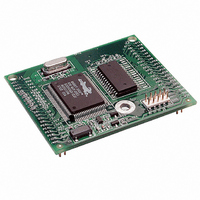20-101-0404 Rabbit Semiconductor, 20-101-0404 Datasheet - Page 15

20-101-0404
Manufacturer Part Number
20-101-0404
Description
MODULE RABBITCORE RCM2000
Manufacturer
Rabbit Semiconductor
Datasheet
1.20-101-0383.pdf
(80 pages)
Specifications of 20-101-0404
Module/board Type
MPU Core Module
Product
Microcontroller Modules
Core Processor
Rabbit 2000
Clock Speed
25.8 MHz
Interface Type
Ethernet, Serial
Flash
256 KB
Timers
5 x 8 bit, 2 x 10 bit
Operating Supply Voltage
4.75 V to 5.25 V
Board Size
48.3 mm x 58.4 mm x 14 mm
Core
RCM2000
Processor Series
RCM2000
Cpu Core
Rabbit 2000
For Use With/related Products
RCM2000
Lead Free Status / RoHS Status
Lead free / RoHS Compliant
Other names
316-1083
3.1 Sample Programs
To help familiarize you with the RCM2000 modules, Dynamic C includes several sample
programs in the Dynamic C
ing these programs will give you a solid hands-on overview of the RCM2000’s
capabilities, as well as a quick start with Dynamic C as an application development tool.
These programs are intended to serve as tutorials, but then can also be used as starting
points or building blocks for your own applications.
Each sample program has comments that describe the purpose and function of the program.
Before running any of these sample program, make sure that your RCM2000 is connected
to the Prototyping Board and to your PC as described in Section 2.1, “Connections.”
To run a sample program, open it with the
pile and run it by pressing
Complete information on Dynamic C is provided in the Dynamic C User’s Manual.
User’s Manual
To develop and debug programs for the RCM2000 (and for all
other Rabbit hardware), you must install and use Dynamic C.
Dynamic C is an integrated development system for writing
embedded software. It runs on an IBM-compatible PC and is
designed for use with Rabbit single-board computers and other
single-board computers based on the Rabbit microprocessor.
Chapter 3 provides the sample programs related to the RCM2000.
NOTE: It is assumed in this section that you have at least an elementary grasp of ANSI C.
If you do not, see the introductory pages of the Dynamic C User’s Manual for a sug-
gested reading list.
3. R
F9
SAMPLES\RCM2000
UNNING
or by selecting
File
Run
S
menu (if it is not already open), then com-
directory. Loading, executing and study-
AMPLE
in the
Run
menu.
P
ROGRAMS
11

















